
Corn earworm larva in mature sweet corn ear.
Corn earworm is the major pest attacking corn ears in the mid-Atlantic U.S. Moth activity has been high in some areas of Virginia such as the Eastern Shore based on pheromone trap catches and grower reports in fields. Sweet corn is one of the most preferred host plants for corn earworm, especially if fresh silks are available when female moths are ovipositing.
For control in sweet corn, it is recommended to begin treatment when the ear shanks emerge or the very first silks appear. Silk sprays should continue on a schedule based on pest pressure on the farm or area blacklight or pheromone trap counts, geographical location, and time of year. This time of year (August) it may be necessary to treat on a 2-3 day schedule.
Dr. Sally Taylor (Tidewater AREC) and I have seen increased levels of pyrethroid (insecticide class 3A) resistance in CEW populations throughout Virginia, and that these insecticides should be used with caution and rotated to other insecticide classes within a season. See the list of recommended insecticides in the table.
During heavy populations and high temperatures, treatments will need to be made according to the legal “days to harvest” of the chemical. For best control during heavy infestations, maximize the gallonage of water per acre, use a wetting agent, and make applications during the early morning if possible. If irrigation or rains wash off the spray within 24 hrs after an application, repeat treatment as soon as the foliage dries.
| Group | Product Name | Product Rate | Active Ingredient(s) (*=Restricted Use) | PHI (d) | REI (h) | Bee TR | |||
| 3A | Lambda-Cy, LambdaT | 1.92 to 3.84 fl oz/A | lambda-cyhalothrin* | 7 | 12 | H | |||
| 3A | Mustang Maxx | 2.24 to 4.0 fl oz/A | zeta-cypermethrin* | 1 | 12 | H | |||
| 3A | Perm-UP 3.2EC | 4.0 to 8.0 fl oz/A | permethrin* | 1 | 12 | H | |||
| 3A | Tombstone 2EC | 0.8 to 2.8 fl oz/A | cyfluthrin* | 0 | 12 | H | |||
| 3A | Warrior II | 1.28 to 1.92 fl oz/A | lambda-cyhalothrin* | 7 | 12 | H | |||
| 3A | Asana XL | 5.8 to 9.6 fl oz/A | esfenvalerate* | 3 | 12 | H | |||
| 3A | Baythroid XL | 0.8 to 2.8 fl oz/A | beta-cyfluthrin* | 0 | 12 | H | |||
| 3A | Bifenture 2EC, Sniper | 2.1 to 6.4 fl oz/A | bifenthrin* | 3 | 12 | H | |||
| 3A | Hero EC | 4.0 to 10.3 fl oz/A | zeta-cypermethrin* + bifenthrin* | 3 | 12 | H | |||
| 1A | Lannate LV | 1.0 to 1.5 pt/A | methomyl* | See label | 48 | H | |||
| 5 | Blackhawk 36WG | 2.2 to 3.3 oz/A | spinosad | 1 | 4 | M | |||
| 5 | Radiant SC | 3.0 to 6.0 fl oz/A | spinetoram | 1 | 4 | H | |||
| 28 | Coragen 1.67SC | 3.5 to 7.5 fl oz/A | chlorantraniliprole | 1 | 4 | L | |||
| Combo products containing a pyrethroid 3A | |||||||||
| Cobalt Advanced | 11.0 to 42.0 fl oz/A | lambda-cyhalothrin* + chlorpyrifos* (Group 1B) | 21 | 24 | H | ||||
| Besiege | 6.0 to 10.0 fl oz/A | lambda-cyhalothrin*+chlorantraniliprole (Group 28) | 7 | 12 | H | ||||
Bt Transgenic Sweet Corn
Bacillus thuringiensis (Bt) sweet corn hybrids are available that express single or pyramided insecticidal proteins for protection against lepidopteran “worm” pests. Attribute® hybrids (Syngenta Seeds) expressing the cry1Ab protein (YieldGard trait) have been available since 1998, and these hybrids now express the Liberty Link herbicide tolerance trait. Performance Series™ hybrids (Seminis Seeds) expressing two Bt proteins (cry1A.105 and cy2Ab2) are also available and these have the RoundupReady gene as well. However, based on multiple years of field trials in Virginia and surrounding states, neither of these Bt traits/varieties provide effective control of CEW due to Bt resistance development to the Cry proteins. Thus, fields planted in these Bt hybrids will need insecticide applications, depending on the insect pressure and level of resistance in the population. In addition, under moderate to high moth activity (early August-early September), many eggs are laid later in ear development after the expressed Bt protein has degraded in dead silk tissue. This loss of protein activity also is accelerated by hot, dry conditions, which cause rapid desiccation of the silk tissue. As a result, earworms and fall armyworms have a greater chance of surviving and invading the ear. Under high moth activity, up to 50% or more of the Attribute ears can become infested with larvae. In this situation, spray schedules of 3 or 4 applications starting 3-4 days after the first onset of silking and repeated 3-4 days apart may be required.
Attribute® II Bt corn hybrids (Syngenta Seeds) with pyramided genes expressing YieldGard and Viptera traits (Vip3A protein) and stacked with the Liberty Link trait are now available. This Bt pyramided gene technology currently provides outstanding nearly 100% control of all lepidopteran pests of sweet corn.
